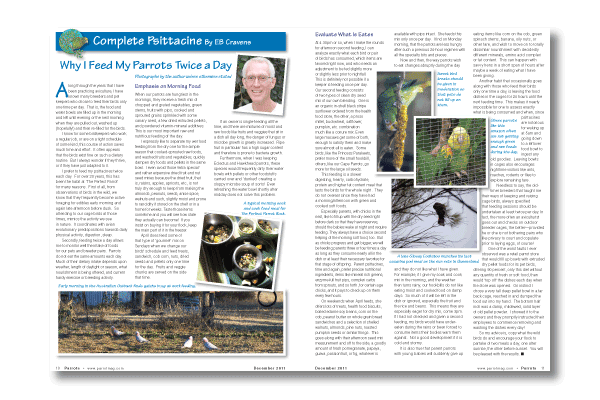
Why I Feed My Parrots Twice a Day
Along through the years that I have been practicing aviculture, I have known many breeders and pet keepers who chose to feed their birds only one time per day. That is, the food and water bowls are filled up in the morning and left until evening or the next morning when they are pulled out, washed up (hopefully!) and then re-filled for the birds.
I know for some birdkeepers who work a regular job, or are on a tight schedule of some kind, this course of action saves much time and effort. It often appears that the birds exist fine on such a dietary routine. But I always wonder if they thrive, or if they have just adapted to it.
I prefer to feed my psittacines twice each day. For over 20 years, this has been the habit at ‘The Perfect Parrot’ for many reasons. First of all, from observations of birds in the wild, we know that they frequently become active foraging for edibles early morning and again late afternoon before dusk. So attending to our cage birds at those times, mimics the activity we see in nature. It coordinates with avian evolutionary predispositions towards daily physical activity, digestion, sleep.
Read more in the magazine…

Those Special Needs of Older Parrots
A recent subscriber to my Bird-keeping Naturally series wrote in the ‘comments’ section, “I would like to hear more about the keeping of older parrots.” To be sure, this is a subject very dear to my heart, as I have many elderly psittacines, some adopted, some that I hand-fed and have had with me for 25 years or more.
In most cases, these birds are to me, my most cherished parrots. My feelings for them that developed over decades, coupled with the wonderful life experience and savvy they now show, are the main reasons for this judgment. Moreover, I worry about them more than I do my younger psittacines.
The elderly parrots in our aviaries tend to get special care. I observe them more keenly, over-feed them a little bit each day so they can pick and choose what their bodies need by way of nourishment. When a psittacine reaches thirty or forty years, I feel it is truly time to make their life easier in as many ways as possible. They get prime cage locations with high up perches and early morning sunlight, they are seldom allowed to undergo the stress of any nesting, and they are monitored carefully if weather turns blustery or inclement, especially during the winter or rainy months.
Read more in the magazine…
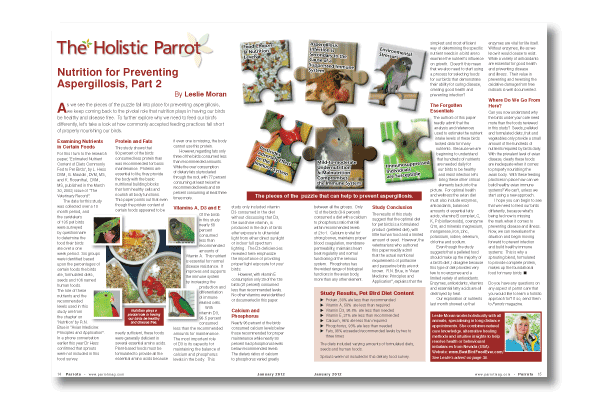
Nutrition for Preventing Aspergillosis, Part 2
As we see the pieces of the puzzle fall into place for preventing aspergillosis, we keep coming back to the pivotal role that nutrition plays in having our birds be healthy and disease free. To further explore why we need to feed our bird’s differently, let’s take a look at how commonly accepted feeding practices fall short of properly nourishing our birds.
Examining Nutrients in Certain Foods
For this I turn to the research paper, ‘Estimated Nutrient Content of Diets Commonly Fed to Pet Birds’, by L. Hess DVM, G. Mauldin, DVM, MS, and K. Rosenthal, DVM, MS, published in the March 30, 2002, issue of “The Veterinary Record”.
The data for this study was collected over a 10 month period, and the caretakers of 135 pet birds were surveyed by questionnaire to determine the food their birds ate over a one week period. Six groups were identified based upon the percentages of certain foods the birds ate, formulated diets, seeds and 106 named human foods.
Read more in the magazine…
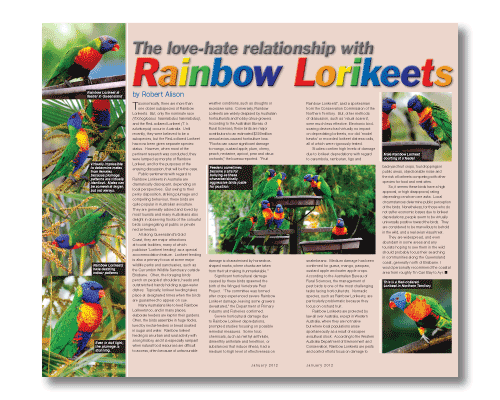
by Robert Alison
Taxonomically, there are more than one dozen subspecies of Rainbow Lorikeets. But, only the nominate race (Trichoglossus haematodus haematodus), and the Red-collared Lorikeet (T. h. rubritorquis) occur in Australia. Until recently, they were believed to be a subspecies, but the Red-collared Lorikeet has now been given separate species status. However, when most of the pertinent research was conducted, they were lumped as morphs of Rainbow Lorikeet, and for the purposes of the ensuing discussion, that will be the case.
Public sentiments with regard to Rainbow Lorikeets in Australia are dramatically discrepant, depending on local perspectives. But owing to their perky disposition, striking plumage and compelling behaviour, these birds are quite popular in Australian aviculture. They are generally adored and loved by most tourists and many Australians also delight in observing flocks of the colourful birds congregating at public or private nectar-feeders.
Read more in the magazine…
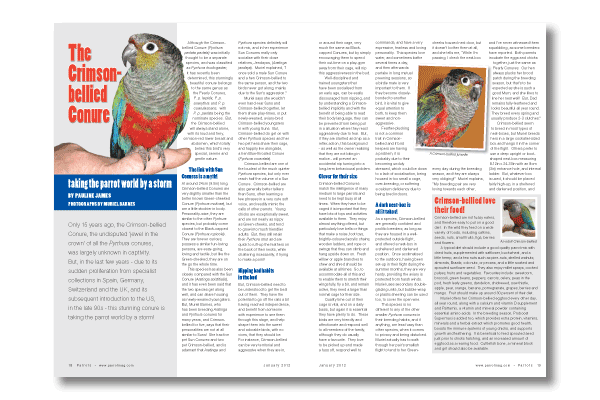
taking the parrot world by a storm. By Pauline James
Only 15 years ago, the Crimson-bellied Conure, the undisputed ‘jewel in the crown’ of all the Pyrrhura conures, was largely unknown in captivity. But, in the last few years - due to its sudden proliferation from specialist collections in Spain, Germany, Switzerland and the UK, and its subsequent introduction to the US, in the late 90s - this stunning conure is taking the parrot world by a storm!
Although the Crimson-bellied Conure (Pyrrhura perlata perlata) was initially thought to be a separate species, and was classified as Pyrrhura rhodogaster, it has recently been determined, this stunningly beautiful conure belongs to the same genus as the Pearly Conures, P. p. lepida, P. p. anerythra and P. p. coerulescens, with P. p. perlata being the nominate species. But, the Crimson-bellied will always stand alone, with its loud and fiery, crimson-red lower breast and abdomen, which totally belies this bird’s very special, serene and gentle nature.
Read more in the magazine…
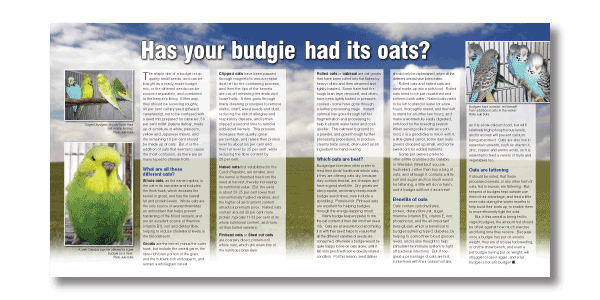
The staple diet of a budgie is top quality small seeds, and can be bought as a ready-made budgie mix, or the different seeds can be sourced separately, and combined to the keeper’s liking. Either way, they should be receiving roughly, 40 per cent canary seed (phalaris canariensis), not to be confused with a seed mix prepared for canaries, 50 per cent millet (setaria italica), made up of a mixture of white, panicum, yellow and Japanese millets, and the remaining 10 per cent should be made up of oats. But, it is the addition of oats that seems to cause the most confusion, as there are so many types to choose from.
Read more in the magazine…






